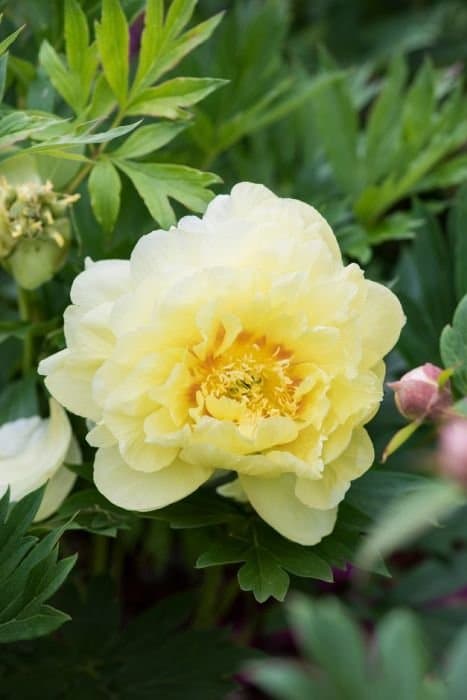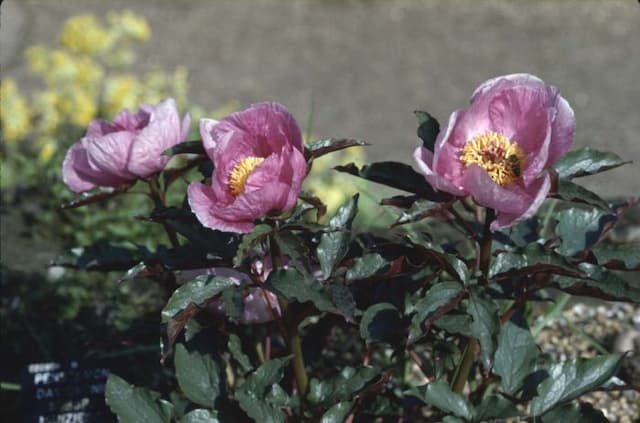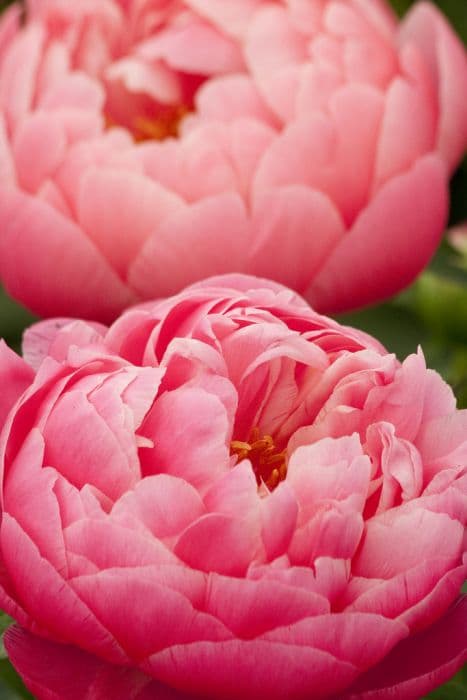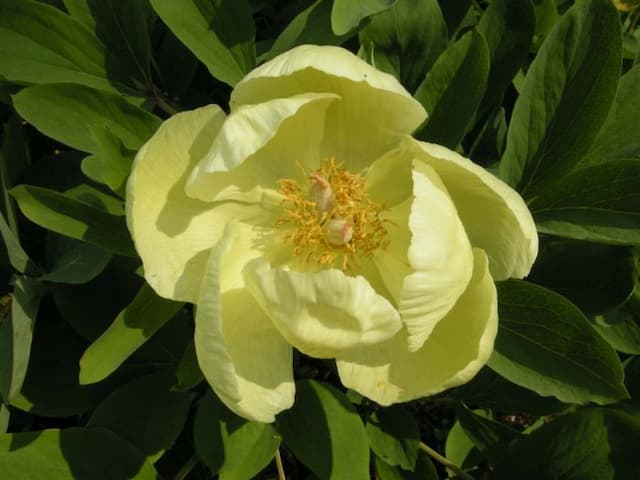Peony 'Coral Sunset' Paeonia 'Coral Sunset'

ABOUT
'Coral Sunset' is a bushy, clump-forming perennial to around 70cm tall with divided, deep green leaves. Fragrant, semi-double blooms open in late spring and early summer with ruffled, coral-pink petals that fade with age to a soft yellow-white
About this plant
 Names
NamesFamily
Paeoniaceae
Synonyms
Coral Sunset Peony
Common names
Paeonia 'Coral Sunset'.
 Characteristics
CharacteristicsLife cycle
Perennials
Foliage type
Deciduous
Color of leaves
Green
Flower color
Coral
Height
2-3 feet (0.6-0.9 meters)
Spread
2-3 feet (0.6-0.9 meters)
Plant type
Herb
Hardiness zones
3-8
Native area
Asia
Benefits
 General Benefits
General Benefits- Attractive Blooms: Paeonia 'Coral Sunset', commonly known as Peony, produces large, ruffled flowers in a vibrant coral-pink hue that fade to a softer pink over time, adding spectacular color and visual interest to gardens.
- Longevity: Peonies are long-lived perennials, potentially thriving in the same location for decades without requiring replanting.
- Low Maintenance: Peonies require minimal care once established, making them an easy choice for gardeners of all skill levels.
- Seasonal Interest: In addition to their springtime blooms, Peonies provide attractive foliage throughout the summer and sometimes offer appealing autumn colors.
- Drought Tolerance: Once established, Peonies can tolerate periods of drought, reducing the need for frequent watering.
- Cut Flower Use: The blossoms of Peonies are highly prized for use in floral arrangements, with a vase life of up to 10 days when cut at the right stage.
- Cold Hardy: Peonies are capable of withstanding colder climates, making them suitable for gardeners in many temperate regions.
- Deer Resistance: Peonies are typically resistant to grazing by deer, which can be beneficial in areas where deer are a common garden pest.
- Attracts Pollinators: Peonies can attract bees and other pollinating insects to the garden, which is beneficial for the pollination of other plants.
- Structural Addition: The sturdy stems and large blooms of Peonies can add structure and form to garden beds or borders.
- Wide Range of Uses: Peonies are suitable for a variety of garden settings, including borders, cottage gardens, and urban courtyard gardens.
- Breeding potential: Peonies have a strong genetic diversity, offering opportunities for creating new cultivars through hybridization.
- Numerous Cultivars: With many cultivars available, gardeners can choose Peonies that best suit their landscape design and personal preferences.
 Medical Properties
Medical PropertiesThis plant is not used for medical purposes.
 Air-purifying Qualities
Air-purifying QualitiesThis plant is not specifically known for air purifying qualities.
 Other Uses
Other Uses- Artistic Inspiration: The vibrant coral hue and elegant form of the peony can serve as a muse for artists and designers, inspiring artwork, fashion, and home decor.
- Culinary Garnish: While not commonly consumed, the petals of the peony can be used as an ornate, colorful garnish for salads and desserts.
- Photography Subject: The striking appearance of the peony makes it a popular subject for photographers, particularly in wedding and nature photography.
- Dye-making: Peonies can provide natural dyes for textiles; their petals can be boiled to extract color for fabric dyeing.
- Crafting: Dried peony petals and seed pods can be used in crafting projects, such as potpourri blends or decorative wreaths.
- Educational Tool: Botany teachers may use the peony in lessons to illustrate plant biology, including flower anatomy and pollination strategies.
- Cultural Symbols: Peonies are often used in cultural festivals and celebrations as they are symbols of prosperity and honor in many societies.
- Event Theming: The peony is used for event theming, such as in garden parties or spring-themed events, due to their association with renewal and lush beauty.
- Flower Arranging Classes: Peonies are popular in flower arranging and floral design classes for their lush, voluminous blooms and versatility in bouquets.
- Perfumery: Some peony varieties are used in perfumery for their light, pleasant fragrance, contributing to the creation of floral scents.
Interesting Facts
 Feng Shui
Feng ShuiThe Peony is often utilized in Feng Shui to promote romance and prosperity. The Peony, particularly in shades of coral like 'Coral Sunset', can be placed in the southwest sector of the garden or home to enhance love and marriage prospects, as this area is associated with relationships in Feng Shui Bagua.
 Zodiac Sign Compitability
Zodiac Sign CompitabilityThe Peony is not used in astrology practice.
 Plant Symbolism
Plant Symbolism- Prosperity: Peonies, including the Coral Sunset variety, are often associated with wealth and good fortune, making them a popular choice in celebrations and weddings.
- Romance: With their lush, full blooms, peonies symbolize romantic love and are believed to bring happiness to relationships.
- Honor: The dignified presence of the peony bloom represents honor and high esteem, reflecting the admiration and respect one may have for another.
- Beauty: Peonies are regarded as a symbol of beauty in many cultures, owing to their impressive and attractive flowers.
- Compassion: Some interpret peonies, with their soft and gentle appearance, as a representation of compassion and nurturing.
 Water
WaterPeonies such as 'Coral Sunset' should be watered deeply once a week if there hasn't been substantial rainfall, ensuring at least 1 inch of water is supplied which approximately equals 0.62 gallons per square yard. It's important to avoid overhead watering to keep the foliage dry and prevent fungal diseases. Instead, water at the base of the plant using a soaker hose or a watering can directed at the soil. During the growing season, especially when buds are forming, consistent moisture is crucial. Reduce watering after the blooming period as peonies are relatively drought tolerant once established.
 Light
LightPeonies like 'Coral Sunset' thrive in full sunlight receiving at least six hours of direct sun daily. Ideal light conditions involve morning sun and afternoon shade in extremely hot climates to prevent the blooms from fading quickly. However, too much shade can limit flowering. Plant peonies in a bright spot where they are protected from strong afternoon sun in hotter regions.
 Temperature
TemperaturePeonies such as 'Coral Sunset' prefer temperate climates and can generally tolerate winter temperatures down to around -20°F. The ideal growth temperature for peonies ranges between 65°F and 75°F during their growing season. Flowering may be inhibited if the temperatures climb above 80°F for extended periods. Peonies require a period of winter chill to set buds for the following year.
 Pruning
PruningPrune 'Coral Sunset' peonies after flowering by removing spent blooms to prevent seed formation and encourage root development. In late fall, after the first frosts, prune the foliage back to the ground to prevent overwintering diseases and pests. Pruning peonies is important not only for the health of the plant but also to maintain a tidy appearance.
 Cleaning
CleaningAs needed
 Soil
SoilPeonies like 'Coral Sunset' thrive in well-draining, fertile soil with a pH of 6.5 to 7.0. A mixture of two-thirds garden soil and one-third compost or well-rotted manure works well. Additionally, incorporating a small amount of perlite or sand can enhance drainage. Avoid heavy, water-logged soils as peonies are prone to root rot.
 Repotting
Repotting'Coral Sunset' Peonies, being long-lived perennials, do not need frequent repotting. They can remain in the same location for many years. Repotting or division is typically only necessary if the flower production declines, which could be after 10-15 years or even longer.
 Humidity & Misting
Humidity & MistingPeonies, like 'Coral Sunset', are adaptable to a wide range of humidity conditions and do not require high humidity. They perform well in the average outdoor humidity found in their growing zones. Excess humidity can promote fungal diseases, so ensure good air circulation.
 Suitable locations
Suitable locationsIndoor
Provide bright light, cool temperatures, and well-draining soil.
Outdoor
Plant in full sun, enrich soil, mulch, and water regularly.
Hardiness zone
3-8 USDA
 Life cycle
Life cycleThe Coral Sunset Peony begins its life as a dormant tuberous root in early spring. It then sprouts stems, foliage, and ultimately large, showy flowers that range from a deep coral to a pale yellow as they mature. After blooming in late spring to early summer, the flowers fade, and the plant begins the process of photosynthesis and energy storage through its green leaves. As autumn approaches, the foliage of the Coral Sunset Peony starts to wither and the plant enters a period of dormancy once frost hits, with the leaves dying back to the ground. During winter, the plant remains dormant, conserving energy within its roots beneath the soil. In the next growing season, this perennial emerges again, completing its cycle and ensuring its survival annually through this repeated pattern of growth, bloom, and dormancy.
 Propogation
PropogationPropogation time
Early fall
Propogation: The Paeonia 'Coral Sunset', commonly known as the Coral Sunset Peony, can be propagated most effectively by division, which is best performed in the fall after the plant has gone dormant. To propagate by division, you need to lift the entire peony plant from the ground carefully, then gently shake off the excess soil. The root system should be divided into sections, each with at least three to five eyes, which are the potential growth points for the next season. These sections are then replanted at the same depth they were growing previously, ensuring that the eyes are no more than 2 inches (about 5 centimeters) below the surface of the soil. The divisions should be spaced 2 to 3 feet (60 to 90 centimeters) apart to allow ample room for growth. Adequate watering is necessary after replanting to help establish the new plants. This method helps maintain the unique characteristics of the 'Coral Sunset' cultivar, making it the most popular means of propagating these peonies.









